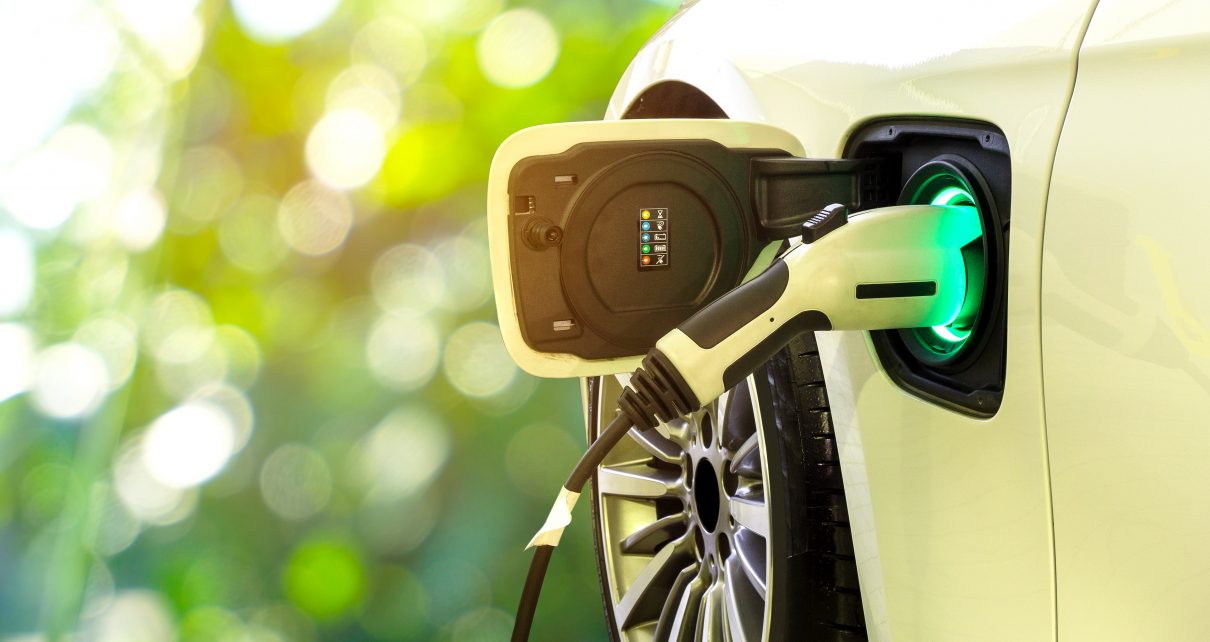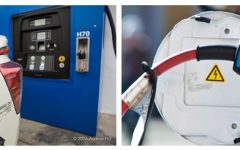
Electric car at charging station with the power cable supply plugged in. (Photo: Smile Fight/Shutterstock)
California Air Resources Board Ups Zero Emission Vehicle Sales Minimum
2020 data showed that only 2% of all cars in California are zero emission
By Evan Symon, April 14, 2022 2:23 am
The California Air Resources Board introduced a new zero-emission vehicle regulation proposal late on Tuesday, which, if passed, would greatly increase the rate of new zero-emissions vehicle sale minimums to 35% by 2026, up to 100% by 2035.
2020 data showed that only 2% of all cars in California are zero emission.
According to the proposed Advanced Clean Cars II regulations, 35% of all new vehicles sold in California in 2026 must be zero-emission, which includes those that are electric, plug-in hybrid, and hydrogen-powered. The rate would then be increased every year, and by 2028 reaching 51% of all new vehicle sales, 68% in 2030, and finally 100% figure previously set by Governor Gavin Newsom in an Executive Order in 2035.
Despite the more set timeline proposal for new cars, older and pre-owned cars are left out of the proposal, allowing them to continue to run on the road past 2035.
In recent years, the state’s more modest goals for zero emission vehicles sales have been met. California originally set a 2025 date to require 8% of all new car sales be electric or otherwise non-fossil fuel. According to the California Energy Commission (CEC) those goals have already been met, with 12% of all new car sales in 2021 being zero emission. However, 2020 data only showed that 2% of all cars in California are zero emission. That data, as well as a growing effort among government organizations and regulators to go after climate change and reduce emissions to improve air quality in the state, pushed CARB to propose the new regulations on Tuesday.
“This is a hugely important inflection point. This rule finally, definitively puts us on the path to 100% zero-emission vehicles,” said CARB board member Daniel Sperling in a statement on Tuesday.
Regulators have addressed the many major roadblocks for adoption, with a major one being a lack of charging stations. As of 2022, there are just over 70,000 charging stations in California, not including at-home plug in options. Currently the CEC has a goal of 200,000 charging stations in the state by 2025, with increased CEC infrastructure funding, budget funds increased by Governor Newsom for stations, and numerous bills in the Assembly and Senate coming up in the last few years to accelerate this goal. The rate would have to increase significantly however to compete against the over 8,000 gas stations in California that offer a refueling of only a few minutes compared to electric vehicles that can take between 8 and 10 hours to get a full charge. It will also need to grow quickly to reach the 1.2 million needed in 2030 for the projected 8 million zero emission vehicles on the road at the beginning of the next decade.
Multiple issues with the CARB proposal
Auto manufacturers noted on Wednesday that while many car companies are currently ramping up hybrid and electric car production and demand, the lack of current infrastructure to support a large number of electric cars, as well as reluctance of other states, may not make the rates even remotely achievable. Other issues, like supply chain problems and the availability of necessary materials such as rare earth minerals for cars, may also slow down production and adoption.
“We are all committed to electrification and a net-zero carbon transportation future,” the Alliance for Automotive Innovation said in a statement on Wednesday. “But it’s critical for governments to ensure that everything from electric car infrastructure, demand, critical minerals and supply chain are in place. [CARB’s] proposed rules will be extremely challenging even in California and may not be achievable in other states.”
The cost of the new electric vehicles has also been a major sticking point, but CARB noted that in the coming years prices of these vehicles are expected to go down. However, one point that may play a major factor is out of state sales then registering them in-state.
“This is one that few people are talking about,” explained Joaquin, an auto trader who works in several Western and Southwestern states, to the Globe on Wednesday. “There is nothing to bar a Californian buying a used car past the 2035 model year in the future in, say, Arizona, they just switching the title over in another state. It’s a bit more complicated than that, but right now it’s doable, and the new rules don’t bar this from happening.”
“When the time comes, there will be a growing business of people in other states buying new cars that are gas powered, then selling them right back to people out of state, since they are then pre-owned. California would have to make the law specifically to ban all car past a model year from being gas-powered, and right now all it says is new car sales. This is a giant loophole that no one is seeing. If legislators in California don’t think people will do this because of the hassle, just look how many Californians go to Mexico or all the way to Nevada for cheaper gas. Look at how many people are now looking to coming to California to take advantage of less restrictive abortion laws. And this is just one loophole. I can’t begin to tell you how many more there are. And what CARB is trying to do will only hasten all of these side businesses and industries for Californians who don’t want to follow this.”
For the next month and a half, public comment on the proposal will be collected. A hearing on the proposal is currently set for June 9th, with a vote expected later in the summer.
- Bill to Require Law Enforcement Disclosure if AI Was Used To Help Write Reports - August 7, 2025
- Gov. Newsom Files FOIA Request To ‘Expose True Cost’ Of L.A. Federal Troop Deployment for Anti-ICE Riots - August 6, 2025
- California Redistricting: How Newsom’s Plan Will Demolish Hard Fought GOP Gains - August 6, 2025





Gotta make sure our friends and trading partners, the Communist Chinese, have a steady and certain production timeline for their EV batteries!!!
The guarantee payments will be delivered to your account in the Caymans, Governor Newsom!!!
What a complete snowjob… and ignorant, virtue-signaling California voters lap this crap up, without any pushback or thoughts about “Gee, where do the rare earth materials in my EV come from, and what processes are utilized to build, shop, store and dispose of these materials”
Nope, instead we get useful idiots clamoring for more electric vehicles to tilt at the windmill altar of “climate change” without any insights about solar minimums or other long-cycle weather influencers…
As you alluded to, how many of these blue check power elites are invested in China-based green energy manufacturing? We know Newsome, Kerry, probably Pelosi, plus everyone who attend Davos.
Enough with CARB and their B.S.! Man oh man, do we need new leadership to void these phony and useless “green” grand schemes that take away choices, enrich usual suspect “friends” whose products are not “environmentally-friendly” in the first place and in fact are extremely environmentally harmful (most especially when they must eventually be dumped as “white elephants”), and impoverish others who cannot afford CARB-ordered new replacement trucks, tractors, cars and other necessary machines to be CARB-compliant. Which is only the tip of the iceberg of the harm and destruction this unelected group of insane and power-mad bureaucrats has wrought without conscience. Ahhhhhh!
I DON’T WANT A DAMN ELECTRIC CAR AND I DON’T WANT TO BE FORCED TO BUY ONE! I LIKE MY DODGE TRUCK WITH THE HEMI THANK YOU VERY MUCH! CARB CAN SHOVE IT UP THEIR @$$ !
^^^ THIS!!!
CA can barely keep the lights on today and they want to add hundreds of thousands of power-hungry chargers? We currently import 60% of our electricity – most of it from coal and fossil fuel – powered generators. Guess we need to ramp this up to be “green”.
I will bet no statewide offices will change incumbents due to the latest “last known address” ballot harvesting voter system.
And yet, the collection of grifters in Sacramento keep winning reelection. The rest of the country got a taste of how it works here in 2020, and I suspect they’ll be getting a much bigger dose of that bitter brew in a few months. Y’know, it doesn’t require an advanced degree in chemistry to produce alternative fuels such as alcohol, or even synthetic gasoline, at home. It really is time to go all in on building a parallel economy. The denizens of Sacramento seldom apply the laws they pass to themselves; perhaps it’s time to start asking ourselves why we allow those laws to be applied to us.
So many problems here, and I’ll skip the environmental issues of battery production and disposal, and what happens when the power goes out and your car is out of charge.
I have a plug-in hybrid minivan for hauling the kids around. Even locally in L.A., if you can find a charging station it’s usually occupied. Many parking decks (e.g. Beverly Hills) come with the warning that if you’re plugged in and not actively charging (done), you can be ticketed and towed. So you have to calculate how long your dinner or shopping might take relative to how long your car takes to charge in deciding whether to park. At my two previous workplaces, there were many more plug in cars than charging stations. I was told if I arrived later than 4 am(!), I’d never get one.
Finally, these electric-powered cars also have other advanced electronics in them. Our minivan’s conventional battery died. We jumped it. The car started but wouldn’t shift out of park (turns out this is by design). It ended up taking two tow trucks and a $500 bill at the dealership just to replace the battery. With my old gas powered car I could buy a battery at Autozone for $70 and replace it myself. I’m worried what future expensive repairs I’m in for! Who can afford this?
Don’t wake up their ‘green” fantasies with a healthy dose of REALITY, Aviva….